Interview: Ubisoft on reinventing Assassin's Creed, punching bears
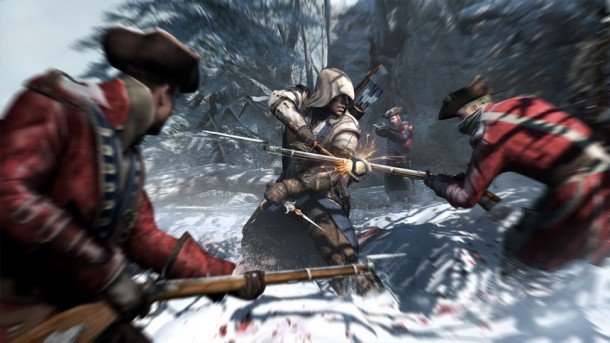
Yesterday we learned more about the main character and world of our Assassin's Creed III in part one of our interview with creative director Alex Hutchinson, senior producer Francois Pelland, and associate producer Jean-Francois Boivin. Story and lore are great, but now we're ready for the really good stuff in part 2: Weapons, mechanics, and the possibility of choking out a bear.
Gadgets and get-ups
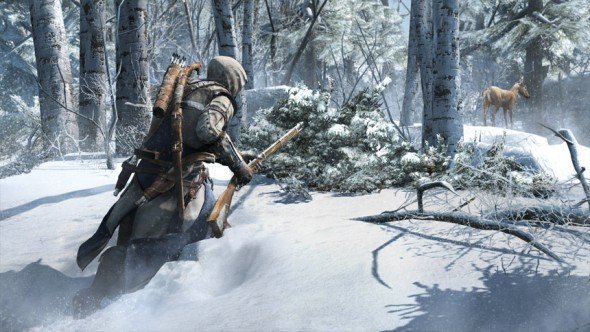
PCG: Can you talk at all about the sort of gadgets we're going to get in this one?
Alex Hutchinson: All of our stuff is real-world... We didn't want to have any sort of invented objects. You have pistols and muskets. They're single-shot, so they're lethal, but one use -almost like you use them and throw them away. All of his weapons are new, and they're all dual-wield, so it'll be tomahawk and knife, or hidden blade and knife–-that sort of thing. And then we have a lot of stuff related to animals, like snares and traps or bait.
PCG: How will animals play into the overall experience? You said you've got traps, but what's the benefit of trapping an animal?
AH: There are different ways that you can get an animal. The example we've been using all day is, if you shoot a bear with buckshot, you don't get a very nice bearskin rug. So we encourage people to get in close and use the different mechanics to essentially assassinate them. George Washington won't be asking you for bearskins, but there are other things you can get involved in-–side quests, or other tasks that need those as objectives.
PCG: Can you make your own gear?
AH: We toyed with the idea for a while, but we decided in the end, no, we wanted him to be iconic. We were imagining a Rambo-type scenario. But no. Connor adjusts his stuff when he gets it, but he doesn't make it.
The biggest gaming news, reviews and hardware deals
Keep up to date with the most important stories and the best deals, as picked by the PC Gamer team.
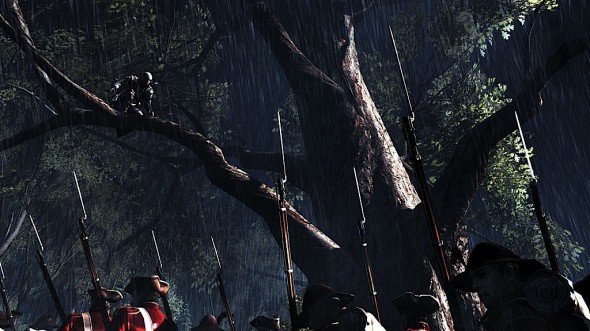
PCG: So there's an upgrade system?
AH: I mean, if you think about it, armor is sort of nonexistent in this period. People don't wear armor. There's a lot of style things you can do in terms of clothes, and there's new weapons you can buy, but not really any sort of linear upgrades.
PCG: So how do we advance the health bar this time around?
AH: You're not. We're toying with regenerating health in this one. It's the idea that we wanted fights to be more dangerous, so your health doesn't regenerate while you're in a fight. You have to actually lose your pursuers. We wanted to get away from health potions, you know what I mean? The notion doesn't really work. So we went with this idea where you have a regenerating health. So no incremental health increases.
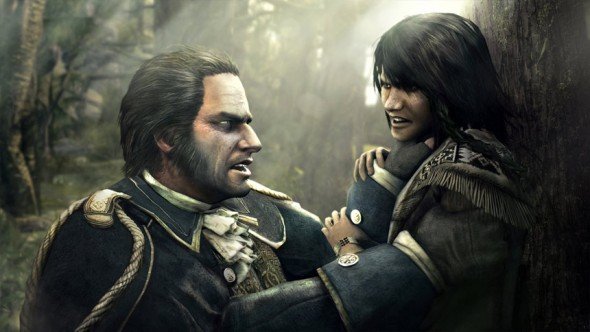
PCG: How does the two-handed combat affect the dynamics of battle? You know, aside from letting you hit things twice instead of once.
AH: The goal is to make it more responsive. The controls don't change inside and outside a fight, so [the button for free run] stays free run, even when you're in a fight. There's no need to lock on to anybody anymore, no targeting. You can fluidly move between people. So our goal was to integrate tools and target-switching, in and out of a fight, seamlessly.
PCG: The fights we saw were almost over in the blink of an eye. Connor ran in and, seconds later, Paul Revere was shouting “Nah, nevermind, guys. The British are leaving. I feel kind of bad for them now.” There was less circling and counterattacking. The rhythm of it was more like “get in, get out, bathe in the blood of your enemies.” How will the big, open environment affect that?
AH: You saw some of them, which were the mobile high spots. If there's tall grass, and you walk slowly through it, you'll crouch down automatically and take cover. So you can use the terrain to your advantage. Also, you're pretty much invisible as long as you're up above people in the trees.
It's a really different feeling, I think. If you're climbing a building, you don't see anything until you reach the top, and then you sort of get the reveal of looking past the building. With the trees, you can always see. Only part of the screen is obscured, so you have a lot of peripheral awareness. And it's non-linear. We like the idea, always, that you could be taking one path through the trees while enemies below are following a road.
In between assassinations
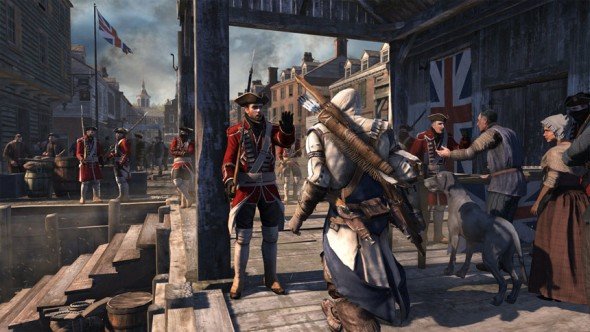
PCG: What variety of non-story activities do we have this time around?
AH: We're not talking about a lot of it, but we can discuss clubs. So, it's history, right? You're replaying history. You can't change history, so it's hard to have choices or big consequences. You can't shoot George Washington and stop the war. It doesn't work. But what we can do is make a world where, if you do certain things, it feels like the world is feeding back into it.
For example, if you walk around and start shooting a lot of deer, then someone might come up to you and say, "Hey, you're a really good shot with that pistol! You should join the hunting club." They give you an invitation to a point on the map you couldn't get to before, and when you go in there, they say, "Hey, welcome to the hunting club! We have this competition running. Go capture the biggest elk." It's this notion that you like hunting on your own, so you did it, and so the game says, "Sure, have more hunting. Here are a bunch of hunting challenges and hunting rewards connected to that."
PCG: So you're going to close off portions of the map?
AH: We're trying to do that as little as possible. We're lucky on some of this-–like Boston. It only had one land bridge at the time, so it's a nice island almost. We don't want to rig the map so much. We have a lot of locations, so we're kind of saying, once you get Boston, you've got Boston. Once you've got New York, you've got New York. There will be a few exceptions to that rule--just for structural reasons--but as much as possible, you get to roam freely.
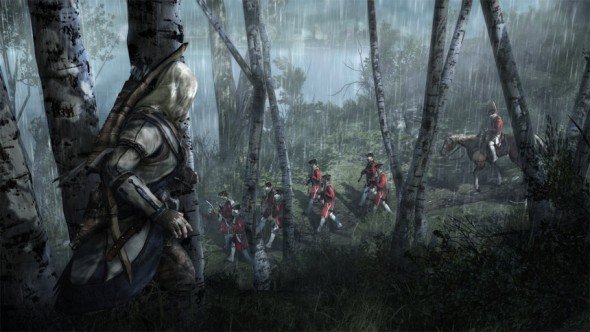
PCG: Will we be able to train and call in other assassins to do our red, white, and blue dirtywork?
AH: There is a mechanic where you get buddies, but no, [not really]. We think that was the guts of Brotherhood, so we don't want to retread anything.
Francois Pelland: The game will feel very different, for sure.
PCG: One of the main criticisms leveled against Revelations was that it felt bloated from a feature standpoint, and that detracted from the core experience, which is assassinating people. Are you moving away from having all of that fluff?
AH: Obviously, I think you get a bit of bloat as you go from sequel-to-sequel with the same trilogy and the same characters. It's very hard to justify why Ezio might lose a device between games, so you're always adding. You get this crazy growth. But with a new hero and a new period and a new setting, we're able to strip away a lot of things that aren't necessary and refocus the game.
FP: That are unnecessary, or just not relevant to the period.

PCG: Are you worried about reactions to that?
AH: Yeah, I'm certain someone will [expect more features]. I'm not too worried, because I don't think it's going to feel small. And I think it's going to feel big enough. There's so much stuff.
FP: We're definitely adding more than we're taking away.
Jean-Francois Boivin: The amount of stuff that's been added is just huge. This is going to be a concern, but I don't think it's a big one.
Wild in the streets
PCG: There was the bit where you used a "chasebreaker” (leaping into a building to lose your pursuers). How many buildings will have interiors like that? Will most buildings at least have a little interior space to explore?
AH: We have more interiors than we've ever had before. There's lots of pubs like the Green Dragon in Boston. There are things like that. There's a lot of set-pieces inside. In terms of that specific mechanic, like a chasebreaker, we have to negotiate all these things with the engineers, obviously, as far as how many we can have. They're all over the city, but they're more like shortcuts. Imagine something like GTA. You're going along, you see the window, and you can cut through. It's not in every building, though.
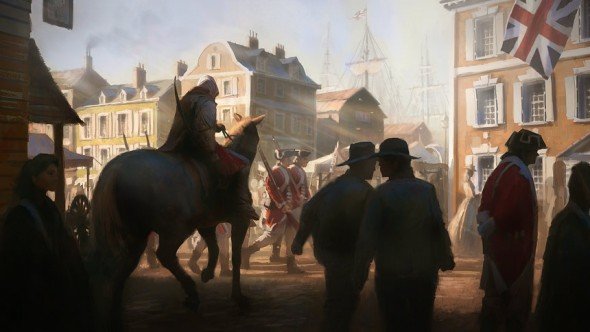
PCG: There cities in previous AC games were all very tall,established cities. Boston and New York, though, aren't as built-out in genral,and especially vertically. How does that change the way that you're designing the game?
AH: It feels like that, but really, in actual fact, it's not that much different from the earlier games. If you think of all the cities in AC, they're about two stories tall. And most of the buildings in Assassin's Creed III--especially in the downtown areas of these cities--they're about two stories as well. Obviously the shape of them is different.
FP: The coliseum in Rome is quite high, but besides that, we have about the same amount of stories.
AH: The big problem has been the roof shapes-–the idea of these angled roofs and how it affects your perception of distance and which direction you're going. That's been more of a pain, to be honest, than the height.
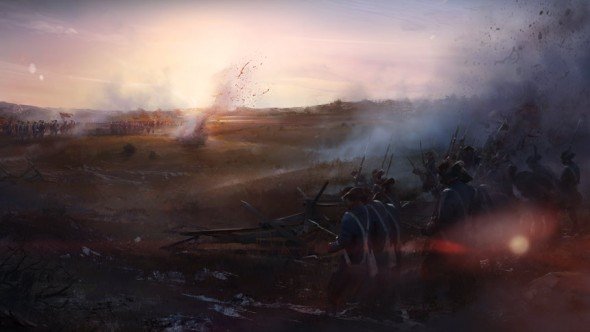
PCG: You emphasized weather mechanics in your presentation, the big example being snow slowing people down, so they're easier to assassinate. Will weather do anything beyond that? Will there be any survival mechanics?
AH: You're still the assassin, so you should be powerful and comfortable in the environment. It's more about how it will affect other characters. Other characters will be struggling to survive, but the assassin is always powerful in the scene. The other things [shown] are just the aesthetics of winter: the tone, the idea that some animals will be hibernating, some will not be. There's availability of things. Some parts of the world may be accessible, while others aren't.
PCG: OK, this one's for me. When you encountered the bear in the demo, you whipped out the hidden blade. But in theory, if I wanted to, could I fistfight a bear? Could I just throw down my weapons and punch it a bunch?
AH: Not really. You could potentially choke out a bear.
PCG: But is it built such that if I threw a punch at a bear, the punch would land and the bear would in some way react to being hit by me?
AH: I haven't tried that. Some of this is relatively new. Ideally, no. It all becomes a little farcical. But if enough people think we should do it, then who knows?

